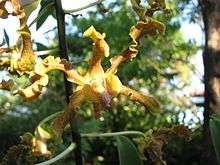Dendrobium discolor
Dendrobium discolor, commonly known as antler orchids,[2] are epiphytic or lithophytic orchids in the family Orchidaceae. They have cylindrical pseudobulbs, each with between ten and thirty five leathery leaves, and flowering stems with up to forty mostly brownish or greenish flowers with wavy and twisted sepals and petals. Antler orchids occur in northern Australia, New Guinea and Indonesia and there are several subspecies and varieties.
| Antler orchid | |
|---|---|
 | |
| Scientific classification | |
| Kingdom: | Plantae |
| Clade: | Tracheophytes |
| Clade: | Angiosperms |
| Clade: | Monocots |
| Order: | Asparagales |
| Family: | Orchidaceae |
| Subfamily: | Epidendroideae |
| Tribe: | Dendrobieae |
| Subtribe: | Dendrobiinae |
| Genus: | Dendrobium |
| Species: | D. discolor |
| Binomial name | |
| Dendrobium discolor | |
Description
Dendrobium discolor is an epiphytic or lithophytic herb with cylindrical green or yellowish pseudobulbs 1–5 m (3–20 ft) long and 30–60 mm (1–2 in) wide with between ten and thirty five leathery leaves 60–160 mm (2–6 in) long and 30–50 mm (1.2–2.0 in) wide. The flowering stem is 200–600 mm (8–20 in) long and bears between eight and forty light brown, reddish brown, dark brown or yellowish flowers. The flowers are 30–80 mm (1.2–3.1 in) long and wide with wavy and twisted sepals and petals. The sepals are 20–35 mm (0.79–1.4 in) long, and 4–7 mm (0.16–0.28 in) wide and the petals are 20–40 mm (0.8–2 in) long and 5–8 mm (0.20–0.31 in) wide. The labellum has mauve to purple markings and is 12–24 mm (0.5–0.9 in) long and 10–15 mm (0.4–0.6 in) wide with three main lobes. The side lobes are large and spread outwards or curve upwards and the middle lobe curves downwards and has at least three ridges and wavy edges. Flowering occurs from April to December.[2][3][4]
Taxonomy and naming
Dendrobium discolor was first formally described in 1841 by John Lindley and the description was published in Edwards's Botanical Register.[5][6] The specific epithet (discolor) is a Latin word meaning "of different colours" or "variegated".[7]
Subdivisions
- Dendrobium discolor var. broomfieldii (Fitzg.) A.D.Hawkes[8] – the canary orchid has greenish yellow to bright golden yellow flowers from April to December, and occurs on the Whitsunday Islands;[2]:396
- Dendrobium discolor subsp. discolor [9] – the golden antler orchid has light brown to dark brown, sometimes yellow to yellowish brown flowers with mauve to purple markings on the labellum, between August and November and occurs in Queensland, from the some Torres Strait Islands to Rockhampton;[2]:396
- Dendrobium discolor var. fimbrilabium (Rchb.f.) Dockrill which occurs in Indonesia, New Guinea and Queensland;[10][11]
- Dendrobium discolor var. fuscum (Fitzg.) Dockrill[12] – the brown antler orchid has relatively small, reddish brown to dark brown flowers with mauve to purple markings on the labellum from April to December and occurs in Queensland, from the some Torres Strait Islands to Mackay;[2]:395
- Dendrobium discolor subsp. incurvata. Liddle & P.I.Forst. which occurs in Papua New Guinea and Queensland.[13][14]
Distribution and habitat
Antler orchids grow in coastal scrub and on mangroves, in coastal rainforest, and woodland, sometimes on rocks. It occurs in Indonesia, New Guinea and Australia.[2][3]
References
- "Dendrobium discolor". World Checklist of Selected Plant Families (WCSP). Royal Botanic Gardens, Kew.
- Jones, David L. (2006). A complete guide to native orchids of Australia including the island territories. Frenchs Forest, N.S.W.: New Holland. ISBN 978-1877069123.:394–396
- "Dendrobium discolor". Orchids of New Guinea. Retrieved 21 November 2018.
- "Durabaculum undulatum var. broomfieldii". Trin keys: Australian Tropical Rainforest Orchids. Retrieved 21 November 2018.
- "Dendrobium discolor". APNI. Retrieved 21 November 2018.
- Lindley, John (1841). "Miscellaneous notes". Edwards's Botanical Register. 27: 21. Retrieved 21 November 2018.
- Brown, Roland Wilbur (1956). The Composition of Scientific Words. Washington, D.C.: Smithsonian Institution Press. p. 270.
- "Dendrobium discolor var. broomfieldii". World Checklist of Selected Plant Families (WCSP). Royal Botanic Gardens, Kew.
- "Dendrobium discolor subsp. discolor". World Checklist of Selected Plant Families (WCSP). Royal Botanic Gardens, Kew.
- "Dendrobium discolor var. fimbrilabium". World Checklist of Selected Plant Families (WCSP). Royal Botanic Gardens, Kew.
- Reichenbach, Heinrich Gustav (1878). "New garden plants". The Gardeners' Chronicle. 9: 40. Retrieved 21 November 2018.
- "Dendrobium discolor var. fuscum". World Checklist of Selected Plant Families (WCSP). Royal Botanic Gardens, Kew.
- "Dendrobium discolor subsp. incurvata". World Checklist of Selected Plant Families (WCSP). Royal Botanic Gardens, Kew.
- Liddle, David J.; Forster, Paul I. (1990). "The recognition of subspecies in Dendrobium discolor Lindley (Orchidaceae)". Austrobaileya. 3 (2): 320. JSTOR 41738767.